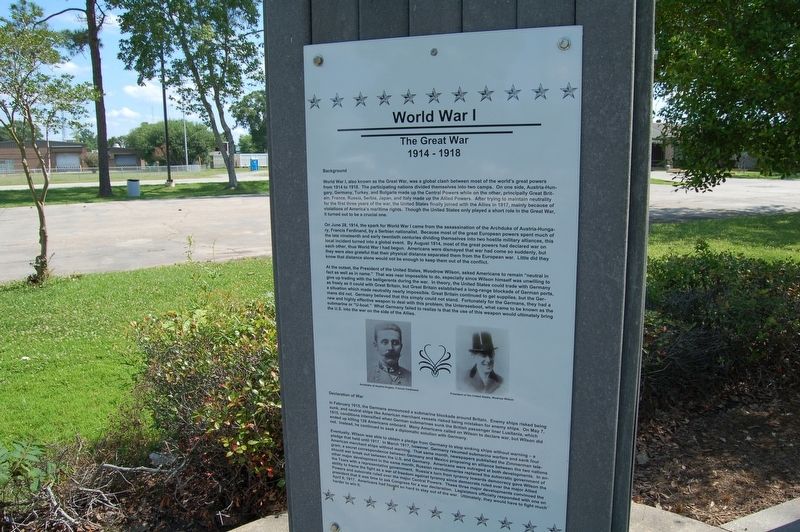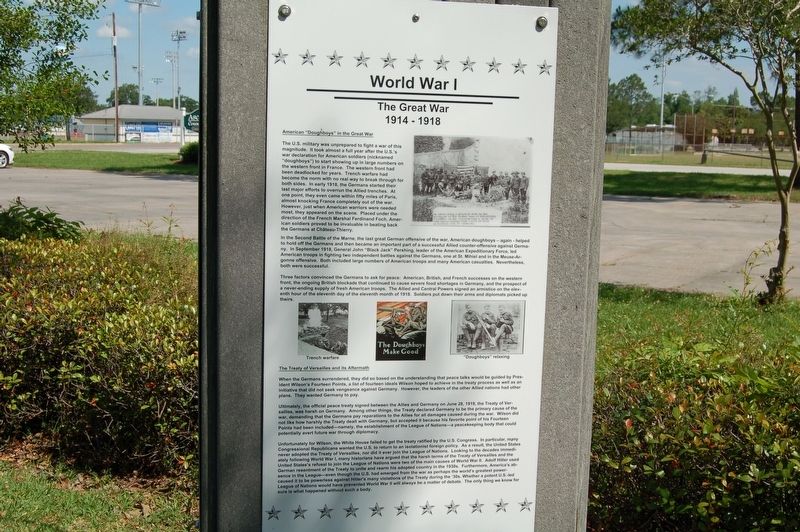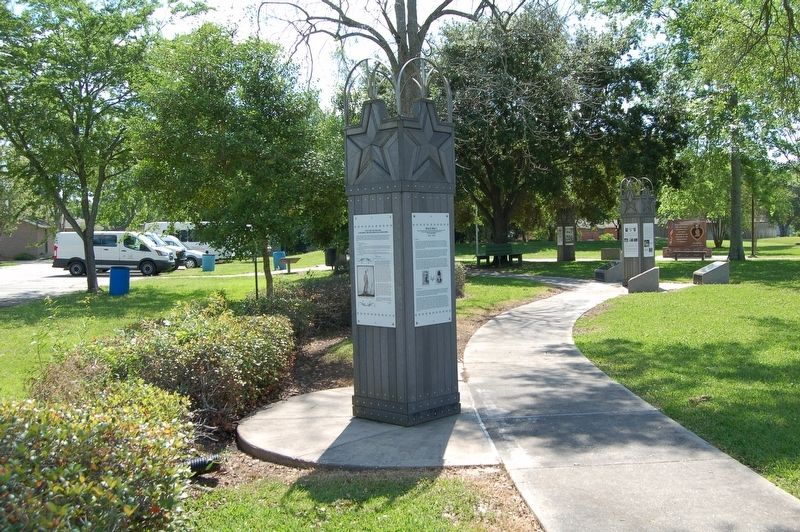World War I
The Great War
— 1914-1918 —
Background
World War I, also known as the Great War, was a global clash between most of the world's great powers from 1914 to 1918. The participating nations divided themselves into two camps. On one side, Austria-Hungary, Germany, Turkey, and Bulgaria made up the Central Powers while on the other, principally Great Britain, France, Russia, Serbia, Japan, and Italy made up the Allied Powers. After trying to maintain neutrality for the first three years of the war, the United States finally joined with the Allies in 1917, mainly because of violations of America's maritime rights. Though the United States only played a short role in the Great War, it turned out to be a crucial one.
On June 28, 1914, the spark for World War I came from the assassination of the Archduke of Austria-Hungary, Francis Ferdinand, by a Serbian nationalist. Because most of the great European powers spent much of the late nineteenth and early twentieth centuries dividing themselves into two hostile military alliances, this local incident turned into a global event. By August 1914, most of the great powers had declared war on each other, thus World War I had begun. Americans were dismayed that war had come so suddenly, but they were also grateful that their physical distance separated them from the European war. Little did they
know that distance alone would not be enough to keep them out of the conflict.At the outset, the President of the United States, Woodrow Wilson, asked Americans to remain “neutral in fact as well as in name." That was near impossible to do, especially since Wilson himself was unwilling to give up trading with the belligerents during the war. In theory, the United States could trade with Germany as freely as it could with Great Britain, but Great Britain established a long-range blockade of German ports, a situation which made neutrality nearly impossible. Great Britain continued to get supplies, but the Ger- mans did not. Germany believed that this simply could not stand. Fortunately for the Germans, they had a new and highly effective weapon to deal with this problem, the Unterseeboot, what came to be known as the submarine or “U-boat." What Germany failed to realize is that the use of this weapon would ultimately bring the U.S. into the war on the side of the Allies.
Declaration of War
In February 1915, the Germans announced a submarine blockade around Britain. Enemy ships risked being sunk, and neutral ships like American merchant vessels risked being mistaken for enemy ships. On May 7, 1915, conditions intensified when German submarines sunk the British passenger liner Lusitania, which ended up killing 128 Americans onboard. Many Americans called on Wilson
to declare war, but Wilson did not. Instead, he continued to seek a diplomatic solution with Germany.Eventually, Wilson was able to obtain a pledge from Germany to stop sinking ships without warning - a pledge that held until 1917. In March 1917, however, Germany resumed submarine warfare and sank four American merchant ships without warning. That same month, newspapers published the Zimmerman telegram, a secret correspondence between Germany and Mexico proposing an alliance between the two nations should war break out between the U.S. and Germany. Americans were outraged at both developments. In another major development in the same month, Russian revolutionaries replaced the autocratic government of the Tsars with a representative government. Russia's turn from tyranny towards democracy gave Wilson the ability to frame the fight as a war of freedom against tyranny since democrats ruled over the major Allied Powers and autocrats ruled over the major Central Powers. These three major developments convinced the president that it was time to ask Congress for a war declaration. Legislators officially responded with one on April 6, 1917. Americans had fought so hard to stay out of the war. Ultimately, they would have to fight much harder to win it.
The U.S. military was unprepared
to fight a war of this magnitude. It took almost a full year after the U.S.'s war declaration for American soldiers (nicknamed "doughboys") to start showing up in large numbers on the western front in France. The western front had been deadlocked for years. Trench warfare had become the norm with no real way to break through for both sides. In early 1918, the Germans started their last major efforts to overrun the Allied trenches. At one point, they even came within fifty miles of Paris, almost knocking France completely out of the war. However, just when American warriors were needed most, they appeared on the scene. Placed under the direction of the French Marshal Ferdinand Foch, American soldiers proved to be invaluable in beating back the Germans at Château-Thierry.In the Second Battle of the Marne, the last great German offensive of the war, American doughboys – again - helped to hold off the Germans and then became an important part of a successful Allied counter-offensive against Germany. In September 1918, General John “Black Jack" Pershing, leader of the American Expeditionary Force, led American troops in fighting two independent battles against the Germans, one at St. Mihiel and in the Meuse-Argonne offensive. Both included large numbers of American troops and many American casualties. Nevertheless, both were successful.
Three factors convinced the
Germans to ask for peace: American, British, and French successes on the western front, the ongoing British blockade that continued to cause severe food shortages in Germany, and the prospect of a never-ending supply of fresh American troops. The Allied and Central Powers signed an armistice on the eleventh hour of the eleventh day of the eleventh month of 1918. Soldiers put down their arms and diplomats picked up theirs.The Treaty of Versailles and its Aftermath
When the Germans surrendered, they did so based on the understanding that peace talks would be guided by President Wilson's Fourteen Points, a list of fourteen ideals Wilson hoped to achieve in the treaty process as well as an initiative that did not seek vengeance against Germany. However, the leaders of the other Allied nations had other plans. They wanted Germany to pay.
Ultimately, the official peace treaty signed between the Allies and Germany on June 28, 1919, the Treaty of Versailles, was harsh on Germany. Among other things, the Treaty declared Germany to be the primary cause of the war, demanding that the Germans pay reparations to the Allies for all damages caused during the war. Wilson did not like how harshly the Treaty dealt with Germany, but accepted it because his favorite point of his Fourteen Points had been included—namely, the establishment of the League of Nations—a peacekeeping body that could potentially avert future war through diplomacy.
Unfortunately for Wilson, the White House failed to get the treaty ratified by the U.S. Congress. In particular, mạny Congressional Republicans wanted the U.S. to return to an isolationist foreign policy. As a result, the United States never adopted the Treaty of Versailles, nor did it ever join the League of Nations. Looking to the decades immediately following World War I, many historians have argued that the harsh terms of the Treaty of Versailles and the United States's refusal to join the League of Nations were two of the main causes of World War II. Adolf Hitler used German resentment of the Treaty to unite and rearm his adopted country in the 1930s. Furthermore, America's absence in the League—even though the U.S. had emerged from the war as perhaps the world's greatest power- caused it to be powerless against Hitler's many violations of the Treaty during the '30s. Whether a potent U.S.-led League of Nations would have prevented World War II will always be a matter of debate. The only thing we know for sure is what happened without such a body.
Topics and series. This historical marker is listed in this topic list: War, World I. In addition, it is included in the Former U.S. Presidents: #28 Woodrow Wilson series list.
Location. 30° 13.711′ N, 90° 54.791′ W. Marker is in Gonzales, Louisiana, in Ascension Parish. Marker can be reached from South Irma Boulevard, 0.3 miles East Worthey Street, on the right when traveling north. Touch for map. Marker is in this post office area: Gonzales LA 70737, United States of America. Touch for directions.
Other nearby markers. At least 8 other markers are within walking distance of this marker. A View From The Trenches: A Doughboy From Donaldsonville Writes Home (here, next to this marker); "The War to End War" (here, next to this marker); The Civil War (a few steps from this marker); a different marker also named Civil War (a few steps from this marker); a different marker also named Civil War (a few steps from this marker); a different marker also named Civil War (a few steps from this marker); World War II (a few steps from this marker); WWII - War In The Mediterranean (a few steps from this marker). Touch for a list and map of all markers in Gonzales.
More about this marker. Located in the Gonzales Veterans Memorial Park.
Credits. This page was last revised on March 15, 2018. It was originally submitted on March 15, 2018, by Cajun Scrambler of Assumption, Louisiana. This page has been viewed 291 times since then and 23 times this year. Photos: 1, 2, 3. submitted on March 15, 2018.


